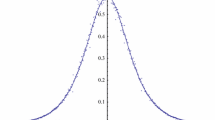Abstract
Statistical models of a single open string avoiding self-intersections in the d-dimensional Euclidean space ℝd, 2 ≤ d < 4, and the ensemble of strings are considered. The presentation of these models is based on the Darwin–Fowler method, used in statistical mechanics to derive the canonical ensemble. The configuration of the string in space ℝd is described by its contour length L and the spatial distance R between its ends. We establish an integral equation for a transformed probability density W(R, L) of the distance R similar to the known Dyson equation, which is invariant under the continuous group of renormalization transformations. This allows us using the renormalization group method to investigate the asymptotic behavior of this density in the case where R → ∞ and L → ∞. For the model of an ensemble of M open strings with the mean string contour length over the ensemble given by \( \overline{L} \), we obtain the most probable distribution of strings over their lengths in the limit as M → ∞. Averaging the probability density W(R, L) over the canonical ensemble eventually gives the sought density 〈W(R, L)〉.
Similar content being viewed by others
References
V. I. Alkhimov, “A d-dimensional model of the canonical ensemble of open strings,” Theor. Math. Phys., 180, 862–879 (2014).
N. N. Bogoliubov and D. V. Shirkov, Introduction to the Theory of Quantized Fields, Wiley, New York (1959).
D. Bridges and T. Spencer, “Self-avoiding walk in 5 or more dimensions,” Commun. Math. Phys., 97, 125–148 (1985).
M. V. Fedoryuk, The Method of Steepest Descent [in Russian], Nauka, Moscow (1977).
M. Gell-Mann and F. Low, “Quantum electrodynamics at small distances,” Phys. Rev., 95, 1300–1312 (1954)
T. Hara and G. Slade, “The lace expansion for self-avoiding walk in five or more dimensions,” Rev. Math. Phys., 4, No. 2, 235–327 (1992).
K. Huang, Statistical Mechanics, Wiley, New York (1963).
L. V. Ovsyannikov, Group Analysis of Differential Equations [in Russian], Nauka, Moscow (1978).
E. C. Titchmarsh, The Theory of Functions, Oxford Univ. Press, Oxford (1939).
Author information
Authors and Affiliations
Corresponding author
Additional information
Translated from Fundamentalnaya i Prikladnaya Matematika, Vol. 21, No. 3, pp. 3–23, 2016.
Rights and permissions
About this article
Cite this article
Alkhimov, V.I. The Canonical Ensemble of Open Self-Avoiding Strings. J Math Sci 237, 337–352 (2019). https://doi.org/10.1007/s10958-019-04161-9
Published:
Issue Date:
DOI: https://doi.org/10.1007/s10958-019-04161-9



